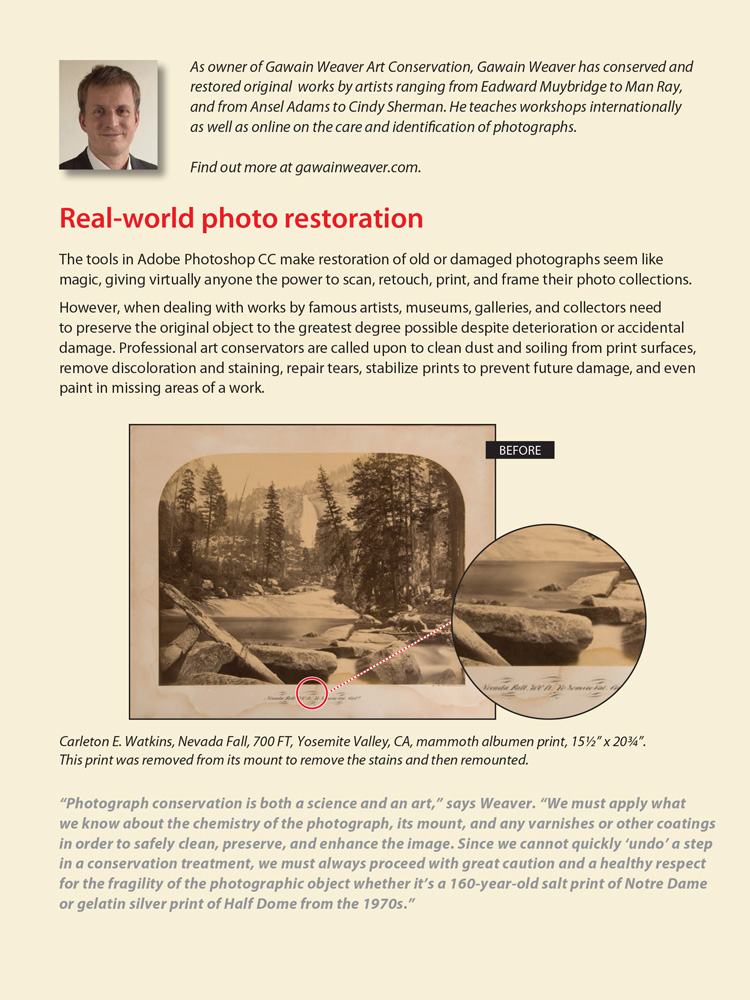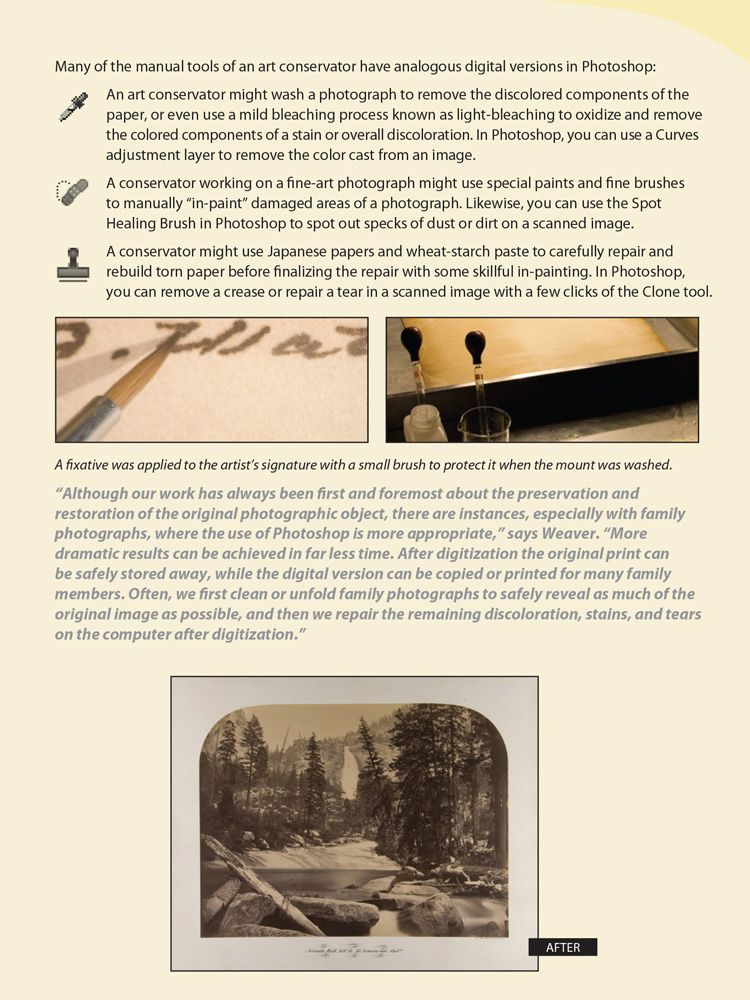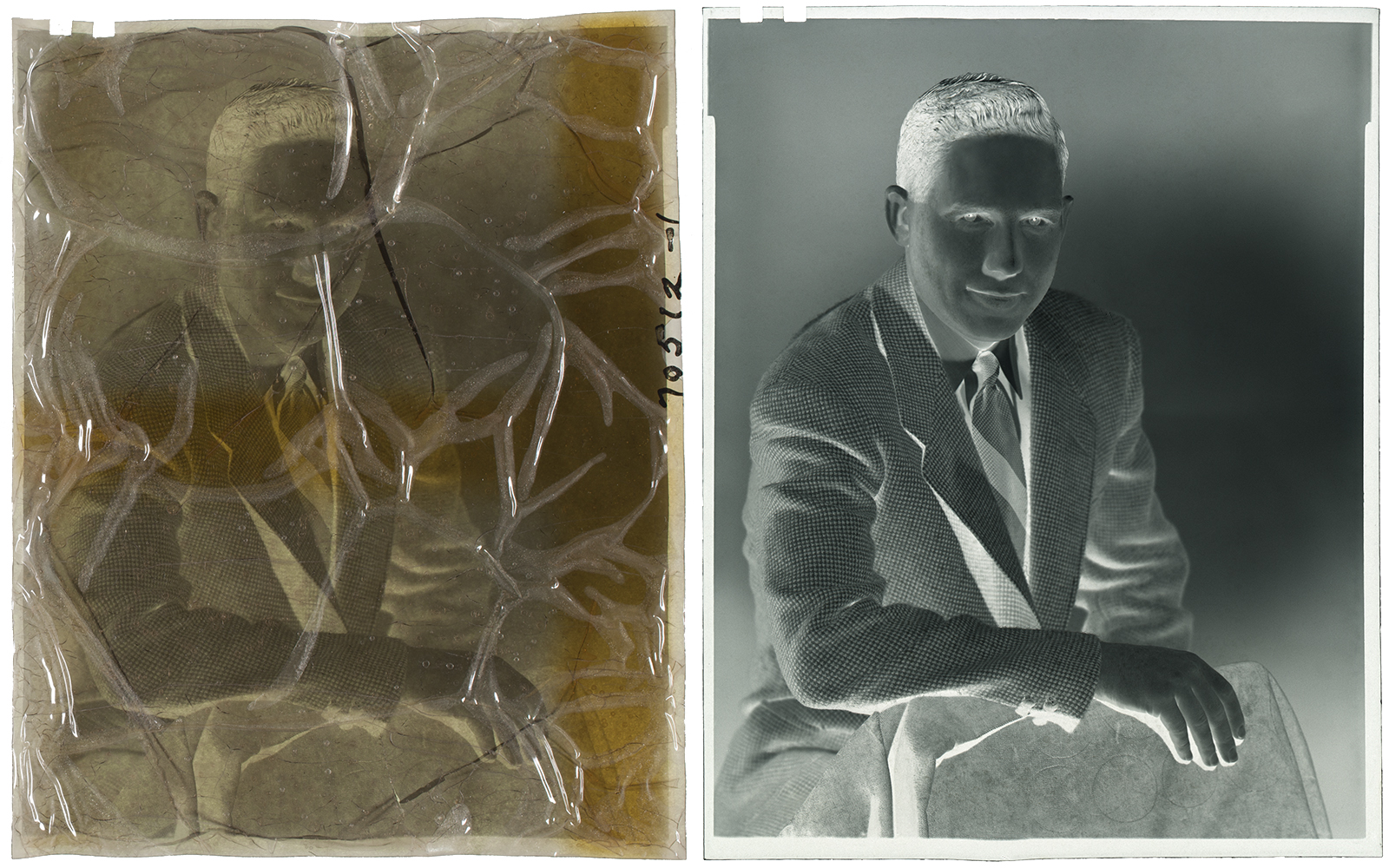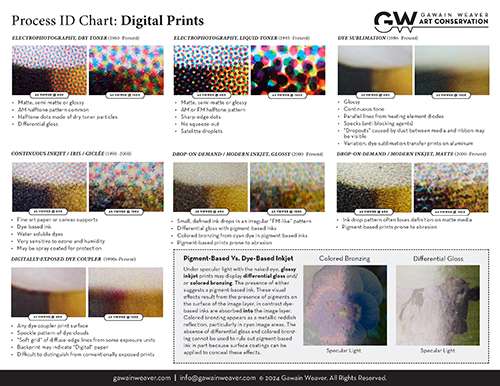News
Here you can find the latest news on our work, research and travels.
"American Civil War Revenue Stamps on Photographs" Added to Library!

We are excited to share a working draft of research by former Conservation Technician Marci Jefcoat titled "American Civil War Revenue Stamps on Photographs"! This working draft focuses on American Civil War Revenue stamps within the brief yet pivotal period 1864-1866, with emphasis on dating and/or estimating initial retail price of cartes de visite based on revenue stamp characteristics. Includes a brief history of revenue stamps, an exploration of cancelation methods from stamps to handwritten markings from the photographer, complete with photographs and analysis of specific examples. Visit our Library to download this resource!
New Process ID Chart for Digital Prints
We're very excited to announce the latest installment in our series of Process ID Charts! The Digital Prints Process ID Chart is now available for free download on our Process ID Resources page. Our process ID charts are valuable quick reference guides which help you to hone in on key identifying characteristics of a print in order to determine the process by which it was made. Find out more by visiting our Process ID Resources page.
Spring 2024 Care and ID of Photographs IN-PERSON Course begins April 9 in Austin, TX
What: Care and Identification of Photographs, IN-PERSON ECLIPSE
When: April 9-12, 2024
Where: Austin, TX (Harry Ransom Center)
Who: Archivists, curators, collectors and complete beginners!
FOR DETAILS AND ONLINE REGISTRATION CLICK HERE!
Registration Includes:
• 4-day in-person course
• 60x LED handheld microscope
• 260-page full-color notebook packet
• OPTIONAL: Basic Photographic Sample Set
Take advantage of this rare opportunity to view a total solar eclipse! On April 8th, a total solar eclipse will be visible from Austin, TX. Come a day early and experience this stunning celestial phenomenon!
You'll also have the chance to see the earliest surviving photograph, The Niépce Heliograph, on display at the Harry Ransom Center.
Course Description:
Whether you are an archivist seeking to invest in your professional development or a family historian pursuing your passion, this 4-day intensive course will introduce you to the history, identification, and preservation of photographic materials. Using a handheld microscope, you will practice identifying 30 of the most commonly encountered photographic materials and formats ranging from daguerreotypes and cartes-de-visite to gelatin silver and inkjet prints. Through lectures, demonstrations, and group discussions, you will become familiar with historical and aesthetic similarities and differences between photographic processes, and critically consider preservation strategies informed by proper ID. Earn a Certificate upon completion, useful for professional or personal projects involving photographic collections.
Spring 2022 Care and ID of Photographs Online Course begins May 2
What: Care and Identification of Photographs, ONLINE
When: May 2 - June 19, 2022
Where: Online
Who: archivists, curators, collections managers, collectors and YOU! No experience necessary!
FOR FURTHER DETAILS AND ONLINE REGISTRATION:
https://gawainweaver.com/workshop/may-2-june-19-2022-care-id-online-workshop
Registration Includes:
• 7-week online course
• 60x LED handheld microscope
• Basic Photographic Sample Set
• 250-page full-color notebook packet
Additional Details:
• The course is hosted via the Canvas Learning Management System and is accessed via your browser from any computer or even tablet or phone (Mac, Windows, Linux, iOS, Android)
• Weekly lectures are pre-recorded and can be watched any time
• Live weekly chat is 1-2 hours as needed with Q&A and guided ID sessions on Zoom, Thursdays @1pm Pacific Time. Attendance is strongly encouraged, but it is recorded for when schedules or time zones conflict. The Zoom app can be accessed on any computer, tablet, or phone.
• Students reported spending 4-6 hours / week on the course on average.
Comments from recent attendees:
"I highly recommend investing in your professional development by taking this multiple week course. You have access to one of the most talented and generous conservators in this field."
—Darlene Bialowski, Principal, Darlene Bialowski Art Services, LLC, Southwest New Hampshire
"For any serious collector, taking this course is time and money extremely well spent."
—Michael R. Whalen, Esq., Pasadena, California
"Definitely the place to come to get a great overview of photographic processes and materials, and how to care for them."
—Erna Tidy, Collection Technician, Documentary Heritage, Tāmaki Paenga Hira, Auckland War Memorial Museum, NZ
"This was the best course I have taken in a long time. The material was new to me, but Gawain presented it clearly and reinforced it through a variety of formats. He is an engaging instructor, and patiently answered all our individual questions."
—Vanessa Hardy, Conservation Technician, San Francisco Public Library
"Gave me skills and knowledge that I was able to apply directly back to my archival work. The online format allowed me to balance my day-to-day work and not have to travel cross-country. . . . Having the chance to learn from Gawain and interact with other colleagues in the course was incredibly beneficial."
—Catherine Mayfield, Library Director, Maryland Historical Society
"I've been wanting to take the Care and ID of Photographs course for years now, and the online version did not disappoint."
—Danielle Creech, Head of Preservation & Digitization, Washington University in St. Louis
Spring 2021 Care and ID of Photographs Online Course begins February 15
What: Care and Identification of Photographs, ONLINE
When: February 15 - April 4, 2021
Where: Online
Who: archivists, curators, collections managers, collectors and YOU! No experience necessary!
FOR FURTHER DETAILS AND ONLINE REGISTRATION:
https://gawainweaver.com/workshop/february-15-april-4-2021-care-id-online-workshop
Registration Includes:
• 7-week online course
• 60x LED handheld microscope
• Basic Photographic Sample Set
• 250-page full-color notebook packet
Additional Details:
• The course is hosted via the Canvas Learning Management System and is accessed via your browser from any computer or even tablet or phone (Mac, Windows, Linux, iOS, Android)
• Weekly lectures are pre-recorded and can be watched any time
• Live weekly chat is 1-2 hours as needed with Q&A and guided ID sessions on Zoom, Thursdays @1pm Pacific Time. Attendance is strongly encouraged, but it is recorded for when schedules or time zones conflict. The Zoom app can be accessed on any computer, tablet, or phone.
• Students reported spending 4-6 hours / week on the course on average.
Comments from recent attendees:
"I highly recommend investing in your professional development by taking this multiple week course. You have access to one of the most talented and generous conservators in this field."
—Darlene Bialowski, Principal, Darlene Bialowski Art Services, LLC, Southwest New Hampshire
"For any serious collector, taking this course is time and money extremely well spent."
—Michael R. Whalen, Esq., Pasadena, California
"Definitely the place to come to get a great overview of photographic processes and materials, and how to care for them."
—Erna Tidy, Collection Technician, Documentary Heritage, Tāmaki Paenga Hira, Auckland War Memorial Museum, NZ
"This was the best course I have taken in a long time. The material was new to me, but Gawain presented it clearly and reinforced it through a variety of formats. He is an engaging instructor, and patiently answered all our individual questions."
—Vanessa Hardy, Conservation Technician, San Francisco Public Library
"Gave me skills and knowledge that I was able to apply directly back to my archival work. The online format allowed me to balance my day-to-day work and not have to travel cross-country. . . . Having the chance to learn from Gawain and interact with other colleagues in the course was incredibly beneficial."
—Catherine Mayfield, Library Director, Maryland Historical Society
"I've been wanting to take the Care and ID of Photographs course for years now, and the online version did not disappoint."
—Danielle Creech, Head of Preservation & Digitization, Washington University in St. Louis
New Process ID Chart for Color Photographic Prints
We're very excited to announce the latest installment in our series of Process ID Charts! The Color Photographic Prints Process ID Chart is now available for free download on our Process ID Resources page. Our process ID charts are valuable quick reference guides which help you to hone in on key identifying characteristics of a print in order to determine the process by which it was made. Find out more by visiting our Process ID Resources page.
Registration Open for the Spring 2020 Care and ID of Photographs Online Course
What: Care and Identification of Photographs, ONLINE
When: March 30 - May 17, 2020
Where: Online
Who: archivists, curators, collections managers, collectors and YOU! No experience necessary!
FOR FURTHER DETAILS AND ONLINE REGISTRATION:
https://gawainweaver.com/workshop/spring-2020-care-id-online-workshop
This course can be taken from any computer (Mac, Windows, even Linux) and only requires access to the Canvas learning management system website and Zoom videoconferencing software (both free). One could even do the course on a tablet or phone running the Canvas and Zoom apps. The weekly live chat on Zoom occurs once a week on Thursdays, at 1pm PST, and is also recorded for students who cannot attend the live chat. Lectures, readings, quizzes, crossword puzzles, and other monster mayhem photo fun are done on your own schedule, each week.
Comments from students who took the course in Fall, 2019:
"I highly recommend investing in your professional development by taking this multiple week course. You have access to one of the most talented and generous conservators in this field."
—Darlene Bialowski, Principal, Darlene Bialowski Art Services, LLC, Southwest New Hampshire
"For any serious collector, taking this course is time and money extremely well spent."
—Michael R. Whalen, Esq., Pasadena, California
"Definitely the place to come to get a great overview of photographic processes and materials, and how to care for them."
—Erna Tidy, Collection Technician, Documentary Heritage, Tāmaki Paenga Hira, Auckland War Memorial Museum, NZ
"This was the best course I have taken in a long time. The material was new to me, but Gawain presented it clearly and reinforced it through a variety of formats. He is an engaging instructor, and patiently answered all our individual questions."
—Vanessa Hardy, Conservation Technician, San Francisco Public Library
"Gave me skills and knowledge that I was able to apply directly back to my archival work. The online format allowed me to balance my day-to-day work and not have to travel cross-country. . . . Having the chance to learn from Gawain and interact with other colleagues in the course was incredibly beneficial."
—Catherine Mayfield, Library Director, Maryland Historical Society
"I've been wanting to take the Care and ID of Photographs course for years now, and the online version did not disappoint."
—Danielle Creech, Head of Preservation & Digitization, Washington University in St. Louis
Photographic Process Controlled Vocabulary Now Available
This list of photographic processes may not have the most exciting title, but over the last five years many of the participants in my Care and ID of Photographs workshop have asked for a list of photographic process names. I have drafted several versions attempting to fulfill the needs of a diverse audience including auction houses, museums, archivists, and curators. Each attempt came up short and the lists have never been shared.
However, over the past year I have worked as a consultant with conservators and curators at the Los Angeles County Museum of Art (LACMA) on an IMLS-funded survey of the museum’s photography collection. This was the perfect opportunity to complete the list and put it to work in cataloging a very large and diverse photography collection. Many modifications were made as we worked together and with the Museum’s TMS database to make the list as accurate and practical as possible. So a special thanks to LACMA and the IMLS for their assistance in developing this document.
There is no perfect list of photographic processes, but I believe this document is a good start and is a practical list for most of the over 500 professionals to whom I have had the pleasure of teaching process ID and photograph preservation over the last 5 years.
Download Photographic Process Controlled Vocabulary as a PDF document here
If you would like the original spreadsheet for editing please send us an e-mail and we will be happy to share it with you.
We have established a LinkedIn group as a forum for discussions about the controlled vocabulary list including suggestions for additions and changes, as well as more general discussions about process ID and nomenclature. Please join us on the Photo Process ID and Nomenclature group.
Real-world photo restoration in Adobe Photoshop CC Classroom in a Book
The Adobe “Classroom in a Book” is the official training workbook from Adobe Systems. Made for each of Adobe’s flagship products, the most recent workbook for the new CC edition of Adobe Photoshop features Gawain Weaver Art Conservation with a comparison between the tools and techniques of a photograph conservator and their digital counterparts in the Photoshop software.


Vinegar Syndrome and Emulsion Stripping of Acetate Negatives

When photographic film with a cellulose acetate support begins to deteriorate we say it has vinegar syndrome because it forms acetic acid (among other deterioration byproducts) and smells like vinegar. The acetate support also shrinks and becomes brittle eventually pulling away from the gelatin image layer in patterns often called channeling. The plasticizer in the acetate support comes to the surface and forms small bubbles between the acetate support and the gelatin image layer. With all this deterioration and deformation it becomes impossible to print or scan the negative and get a good quality result. Cold storage is the only way to slow down this deterioration process, but it can’t reverse deterioration that has already occurred. So for some negatives it is necessary to separate the very thin gelatin image layer from the deteriorating support. This technique of “emulsion stripping” was first pioneered in Canada in the 1960s as a photomechanical layout technique for combining graphic elements in the creation of camera ready art for printing. It was adopted in the United States also for graphic arts purposes in the 1970s and by the 1980s was being used for the first time as a conservation method for deteriorated acetate negatives. It turns out that even after all the dramatic deterioration of the acetate film base, the gelatin image layer is usually still OK, and can be separated, scanned, and then stored safely. The new digital image file can then be written back to a new sheet of polyester-base film or stored in a digital repository. Gawain Weaver Art Conservation has been performing this process for several years. Please contact us to discuss your project.


